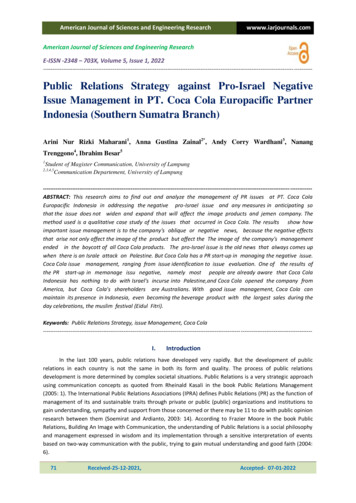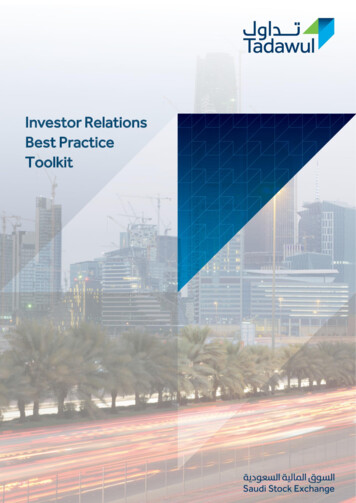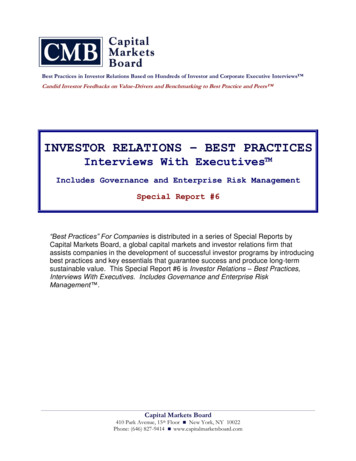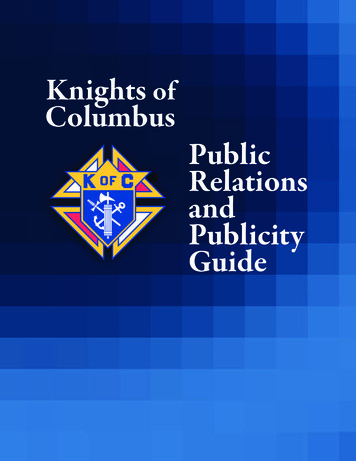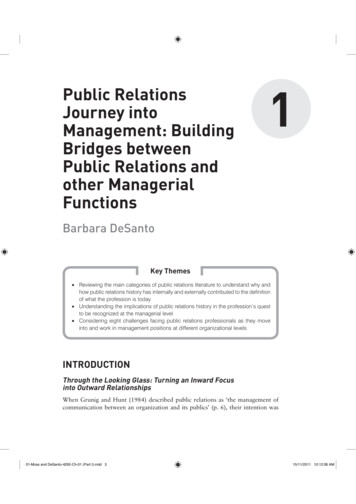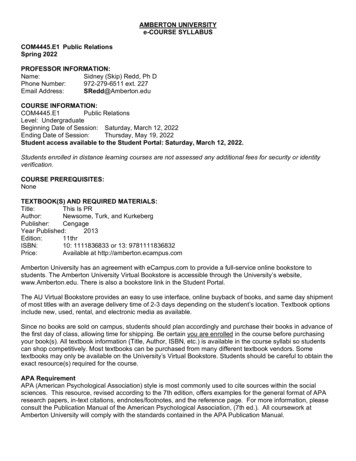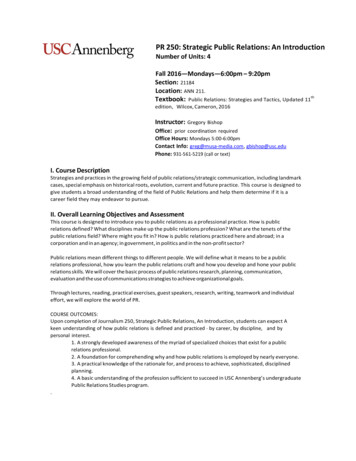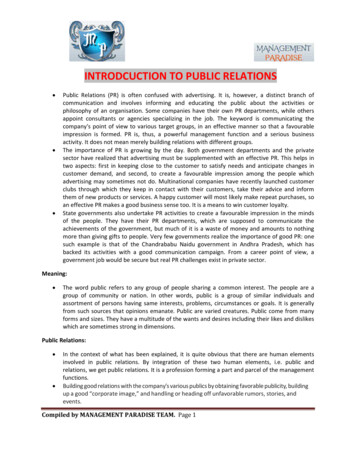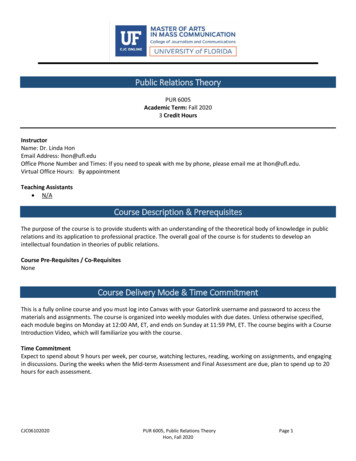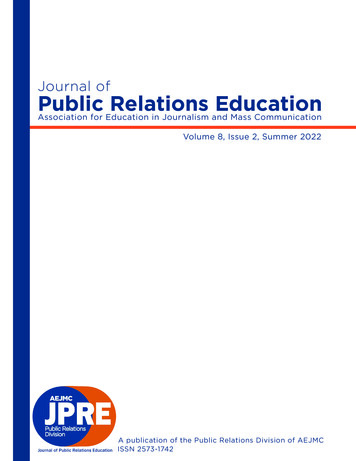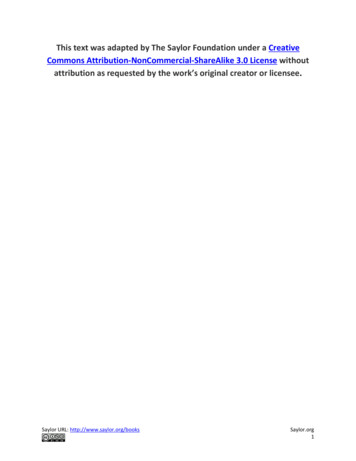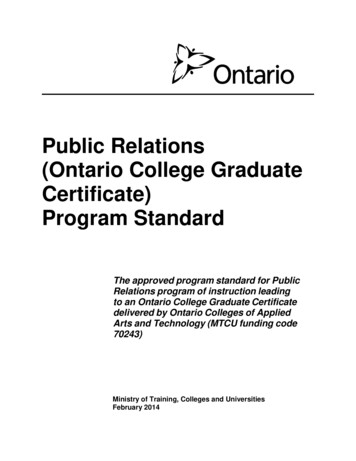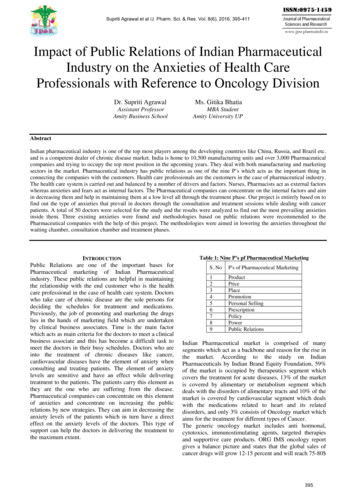
Transcription
Supriti Agrawal et al /J. Pharm. Sci. & Res. Vol. 8(6), 2016, 395-411Impact of Public Relations of Indian PharmaceuticalIndustry on the Anxieties of Health CareProfessionals with Reference to Oncology DivisionDr. Supriti AgrawalMs. Gitika BhatiaAssistant ProfessorAmity Business SchoolMBA StudentAmity University UPAbstractIndian pharmaceutical industry is one of the top most players among the developing countries like China, Russia, and Brazil etc.and is a competent dealer of chronic disease market. India is home to 10,500 manufacturing units and over 3,000 Pharmaceuticalcompanies and trying to occupy the top most position in the upcoming years. They deal with both manufacturing and marketingsectors in the market. Pharmaceutical industry has public relations as one of the nine P’s which acts as the important thing inconnecting the companies with the customers. Health care professionals are the customers in the case of pharmaceutical industry.The health care system is carried out and balanced by a number of drivers and factors. Nurses, Pharmacists act as external factorswhereas anxieties and fears act as internal factors. The Pharmaceutical companies can concentrate on the internal factors and aimin decreasing them and help in maintaining them at a low level all through the treatment phase. Our project is entirely based on tofind out the type of anxieties that prevail in doctors through the consultation and treatment sessions while dealing with cancerpatients. A total of 50 doctors were selected for the study and the results were analyzed to find out the most prevailing anxietiesinside them. Three existing anxieties were found and methodologies based on public relations were recommended to thePharmaceutical companies with the help of this project. The methodologies were aimed in lowering the anxieties throughout thewaiting chamber, consultation chamber and treatment phases.INTRODUCTIONPublic Relations are one of the important bases forPharmaceutical marketing of Indian Pharmaceuticalindustry. These public relations are helpful in maintainingthe relationship with the end customer who is the healthcare professional in the case of health care system. Doctorswho take care of chronic disease are the sole persons fordeciding the schedules for treatment and medications.Previously, the job of promoting and marketing the drugslies in the hands of marketing field which are undertakenby clinical business associates. Time is the main factorwhich acts as main criteria for the doctors to meet a clinicalbusiness associate and this has become a difficult task tomeet the doctors in their busy schedules. Doctors who areinto the treatment of chronic diseases like cancer,cardiovascular diseases have the element of anxiety whenconsulting and treating patients. The element of anxietylevels are sensitive and have an effect while deliveringtreatment to the patients. The patients carry this element asthey are the one who are suffering from the disease.Pharmaceutical companies can concentrate on this elementof anxieties and concentrate on increasing the publicrelations by new strategies. They can aim in decreasing theanxiety levels of the patients which in turn have a directeffect on the anxiety levels of the doctors. This type ofsupport can help the doctors in delivering the treatment tothe maximum extent.Table 1: Nine P’s pf Pharmaceutical MarketingS. NoP's of Pharmaceutical al SellingPrescriptionPolicyPowerPublic RelationsIndian Pharmaceutical market is comprised of manysegments which act as a backbone and reason for the rise inthe market. According to the study on IndianPharmaceuticals by Indian Brand Equity Foundation, 59%of the market is occupied by therapeutics segment whichcovers the treatment for acute diseases, 13% of the marketis covered by alimentary or metabolism segment whichdeals with the disorders of alimentary tracts and 10% of themarket is covered by cardiovascular segment which dealswith the medications related to heart and its relateddisorders, and only 3% consists of Oncology market whichaims for the treatment for different types of Cancer.The generic oncology market includes anti hormonal,cytotoxics, immunostimulating agents, targeted therapiesand supportive care products. ORG IMS oncology reportgives a balance picture and states that the global sales ofcancer drugs will grow 12-15 percent and will reach 75-80 395
Supriti Agrawal et al /J. Pharm. Sci. & Res. Vol. 8(6), 2016, 395-411billion in sales by 2012. The Indian oncology market isestimated to be about INR 7,000 to 8,000 million with aCAGR of 30% with Antimetabolites, Protein KinaseInhibitors and Aromatase Inhibitors leading the Indianoncology market. The oncology market according to IndianBrand Equity Foundation has a share of 3% of the overallpharmaceutical market in India. But, Oncology market isslow in India in terms of buying power of the people andsupply chain.In recent years, several foreign players have madeacquisitions in India to get a foothold in the country’sPharmaceutical market and leverage on the technical andcost efficiency of Indian companies. More number ofcompanies is forming Joint Ventures to get the benefit ofresearch and development from the local players. Largefirms of developed markets are venturing with the Majorplayers of India to develop new medicines.Oncology drug market is always trending and alwaysshared by many players in the market. The main reasons forthe rise in Pharmaceutical market are the increase in theamount spent on healthcare in countries like China, betteraccess to healthcare by middle class families in countrieslike India and increase in population prone to diseases incountries like US and Japan. Oncology market has its owndrivers. They act for the treatment of chronic diseases andpatients approach for them as it is necessary. The necessityof the patients acts as the main driver for the Oncologymarket globally.Health Care Professionals during Consultation andTreatment Phases:Health care professionals deal with the cancer patientssuffering with different stages and it becomes a difficulttask for both the doctors and patients to fight against thechronic disorder. Lot of challenges arises when it comes tothe treatment of a chronic disorder and when it has beendiagnosed in the last stages.The consultation and treatment process are driven by someinternal and external factors. These factors help inachieving the health care dynamics. Hospital managers,nurses, clinical business associates, lab technicians areexternal forces. The fears or anxieties that rise during theprocess of consultation and treatment within the doctorsand the patients are internal factors. The external factors actin a positive manner and provide support to doctors indelivering the necessary treatment and patients in helpingthem to receive the treatment in a proper manner.Internal factors have to be controlled by the individual andthe external factors can help in maintaining the internalfactors at a low level. When it comes in treatment of achronic disease, the internal factors play an important roleand can affect the phases of the consultation and treatment.Hence an understanding about the internal factors helps inproposing methods which aim in decreasing them andmaintaining them at a minimum level.Anxiety is “a diffuse, unpleasant, vague sense ofapprehension” which can be simplified as a response to anunknown threat. The study of anxieties that exist or evolveduring the doctor-patient interaction is useful inunderstanding the real sense of consultation and helps thedoctor to approach the patient in an alternative mannerwhich improves the process of delivering health care.Anxieties of DoctorDoctors deal with a number of cases in their lifetime. Thescenario of Anxieties exists in any type of treatment but itexists more when he deals with chronic diseases. When itcomes to the treatment of Cancer, it deals with morechemotherapy or radiotherapy sessions with a number ofmedications added up with the anxieties of patients. Hence,the doctor has to stand as the sole person who has to takecare of the treatment and make sure that the patient isresponding to the treatment provided. He has to take all thesteps right from the consultation session towards thedischarge of the patient from the hospital. During thisprocess, Anxieties play an important role in influencing theway the doctor is responding to the patients. Hence a studyof anxieties is necessary which helps the doctor tominimize the unwanted elements and increase the output atthe end.The anxieties of doctors are classified into three types:1. Interactional Anxiety2. Existential Anxiety3. Entitlement AnxietyInteractional anxietyConsultation is the first part of the treatment process andinteraction takes place between the patient and doctor.They discuss all the biomedical aspects regarding thedisease and plan for the treatment schedule. Doctor meets anumber of patients in a day and deals with many cases ofcancer. But he has to be calm and composed in every newcase dealt with. Anxiety that arises when having aninteraction with the patient is Interactional anxiety. Thetype of anxiety that arises during the interaction withpatients is interactional anxiety. It becomes a difficult taskto the doctor with patients when they come to know thatthey are suffering with a chronic disorder. Patients becomeunstoppable and insatiable while having an interaction.Anxiety should be kept at low level and treatment has to bedelivered in each and every case.The variables which are considered for interactionalanxiety are mentioned below: Fear of meeting the expectations Fear of being blamed Fear of unknown and untaught Fear of unleashing the reactions Fear of expressing emotions Fear of not knowing the all the answersExistential anxietyDoctor prescribes medications and has a ten minute talkwith the patient within whom he explains the necessity oftreatment, schedules, lifestyle and medications. Sometimes,after having a hectic schedule or having some kind ofdisturbance in his mind, he may not be able to explain allthe things and sometimes he might miss some importantpoints which are essential to be known by the patient. Theanxiety that arises when the doctor feels that he missedsome serious implications which might result in the worst396
Supriti Agrawal et al /J. Pharm. Sci. & Res. Vol. 8(6), 2016, 395-411scenarios of the patients is existential anxiety. Missing anyserious implication may result in loss of faith towards himand also the loss of professional identity which is anessential principle for the doctor. Existential anxiety is afactor which arises due to the internal fear.The variables which are considered for existential anxietyare mentioned below: Fear of losing professional identity Fear of reality Fear of guilty Fear of dissatisfaction Fear of personal illness or deathEntitlement AnxietyDoctor prescribes medications in the prescription which isto be followed by the patient and he has to follow thedosage accordingly. Sometimes, the drugs prescribed mightcause some unwanted complications which might push thehealth into more negative zone. Doctor has a detailedconsultation session with the patient and sometimes, due totime restrictions, he can close the session a bit earlier whichmight be uncomfortable to the patient. The anxiety thatarise in the doctor when he starts fearing from thesurrounding conditions during consultation and treatment iscalled Entitlement anxiety.The variables which are considered for entitlement anxietyare mentioned below: Anxiety about inappropriate consulting Anxiety about the responsibility of maintainingthe emotional levels of patient within thespeculated time period Fear of missing some important points inconsultation such as Health Background information (family history) Pharmacodynamical aspects Pharmacokinetic aspectsThe anxiety levels in the case of chronic disorders likecancer are at a high level as the chances of achievingsuccess are at a lower side. Pharmaceutical companies asdiscussed earlier are trying to attain a maximum share ofthe oncology market by coming up with new drugs andtheir approvals. The marketing department of thepharmaceutical companies recruits medical representativeswho approach the doctors to explain about the drugsmanufactured by the companies. This is called Personalselling, 5th in the list of Nine P’s proposed by Subbarao.Health care professionals dealing with patients sufferingwith one of the chronic disorder have less time to meet themedical representatives and have a look at the productsmanufactured by them. Hence, the companies can come upwith a new idea of lowering the anxiety levels in both thepatients and doctors with Public relations, 9th in the list ofNine P’s proposed by Subbarao. The public relations can indecreasing the anxiety levels of the doctors and patients,helps in delivering the correct treatment, increases the casesof success and helps in attaining the right health caredynamic system.LITERATURE REVIEWPharmaceutical Marketing in IndiaSubbarao Chagmati (2007) in his work “PharmaceuticalMarketing in India” critically studied the concept ofPharmaceutical marketing in Indian context. The IndianPharmaceutical market is based on the proposed nine Psystems. The nine P’s mentioned in his book are Product,Price, Place, Promotion, Personal selling, Prescription,Policy, Power and Public relation. These help in creatingstrategies which assists in diffusing the market into thedemand side. Every P has its own importance and all ofthem have to be given an equal importance whichformulating strategies necessary to launch a product and tomake it through the market filled with competitor products.Indian Pharmaceutical market is filled with foreign players.Hence the local players have to take all of these intoaccount and formulate strategies helpful for the companyand involves in successful delivering of health care. He alsosuggested some changes to be taken place in the marketingdivision of the companies. Direct to consumeradvertisements, promoting products by enhanced publicrelations, efficient training for the sales force about theproduct and price related aspects and introduction of newmethodologies of marketing the product can change thescenario of the Indian Pharmaceutical Market in theupcoming years.Harrel and Frazier (1999) in their book “Marketing:Connecting with customers” provided a deep discussionover the product which is the first in the list of nine P’s ofIndian Pharmaceutical marketing. Product is the materialwhich has to be provided to the consumers or customersand can be easily categorized into three dimensions. Coreproduct, Branded Product and Augmented product are thecategories that come under the first P. Basic functions andbenefits provided to the consumer are indicted by the coreproduct. Packaging, characteristics, quality, style and brandimage are indicated by the brand product. Core benefit andphysical being are covered under the augmented product.The companies should calculate the type of product theywant to provide to the customer which helps inemphasizing importance the basic elements of therespective category. Pharmaceutical products are admixedversions of both the core product and augmented product.The companies have to lay more emphasis on the functions,core benefits, and physical being according to the necessityof the patient.in their work titledKotler & Armstrong (2001)“Principles of Marketing” had a discussion over the pricewhich is the second in the list of nine P’s of IndianPharmaceutical marketing. Pricing has to be designeddepending upon the material cost, product cost andmanufacturing cost. Pricing has to attain the basicobjectives of market survival, growth of sales, attainmentof profitability, competitive pricing and enhancement ofboth the quality and image. Pricing varies from branded togeneric versions. Branded drugs have a price higher thanthose of generic drugs. Companies have to concentrate onthe low price versions and add quality as it helps the397
Supriti Agrawal et al /J. Pharm. Sci. & Res. Vol. 8(6), 2016, 395-411customers to opt for these products. These strategies help inproviding more options to the customers.Harrel and Frazier (1999) in their book of “Marketing:Connecting with customers” highlighted the importance ofPlace which is in be the third in the list of nine P’s ofIndian Pharmaceutical marketing. According to the authors,two strategies can be followed by companies dependingupon the place of selling. The place of selling the drugs is aPharmacy store. The two main types of strategies followedby the companies basing on the place as the main criteriaare the Push and Pull strategy. The “Push” strategy uses acompany sales force and trade promotion activities tocreate a demand for a product whereas the “Pull” strategyrequires advertising and consumer promotion to build upconsumer demand for the product. The strategies developedaim in creating demand for the product.Mickey Smith (2001) in his book titled “PharmaceuticalMarketing in 21st Century” narrated the changes that haslaid metamorphosis for the Pharmaceutical industry. Thepresent scenario of the Pharmaceutical industry is the resultof the metamorphosis that has taken place form the pasdecades. The industry is in serious transition phase and hecovered the aspects that went beyond P’s of pharmaceuticalmarketing. The author provided an excellent review aboutthe excellence of Pharmaceutical industry. He laid moreemphasis on direct to consumer education which plays animportant role in educating the consumers about the aspectsregarding health care which results in improvedrelationship with doctors, thus promoting the productmanufactured by the company.Anshal Kausherh (2006) in his book titled“Pharmaceutical Marketing and Emerging Trends”explained about the changing global economy which hasconcern over healthcare. The author emphasized more ondeveloping new strategies for reaching out the customers.DTCA - Direct to consumer advertising is the proposednew strategy and also agreed that the Pharmaceuticalcompanies and their agencies will come up with newcreative solutions in near future. This strategy results ininnovative adverting and media campaigning’s. The authorwarned the companies about the competition ofpharmaceuticals across the boundaries and the intrusion offoreign players into the local market. He suggested incrafting a competitive strategy which is consumer centricand country specific as it aims in better consumersatisfaction.Umesh Vyas (1994) in his paper titled “A project oninnovative marketing policy” narrated the changes that hastaken place in the process of pharmaceutical marketing.Pharmaceutical marketing has gained a large momentum bybrand promotion and through personalized communicationpharmaceutical selling process. This process involves theattention of Doctors through personalized communicationwhere brands are promoted through audio – visualmethods, printed materials and detailing. The researcheralso felt that this type of approach consumes some of thevaluable time of the doctors and when this time is shifted indealing with patients, better results are provided. He alsofelt that innovative marketing strategies play a vital role inmaking a drug successful. The demand and supply sideshould work together in bringing out innovative products.He suggested the utilization of P’s of the pharmaceuticalmarket in a better way which helps to the parties involvedin the health care system.Meera Vijay (2006) in her thesis on “A study on impact ofdirect to consumers pharmaceutical marketing under Indianconditions,” studied the method of direct to consumerpharmaceutical advertising in chronic and major ailmentsin the area of Mumbai. The author highlighted the aspect ofmaintaining public relations in the areas of chronicdisorders. Patients suffering from chronic disorders preferto consult a doctor and then go for medications asprescribed. This study threw light over the new concept ofdirect to consumer advertisements where the respondentsfelt positive to this kind of approach. Design of Direct toconsumer pharmaceutical help-seeking advertisementsmust be simple, attractive and motivate consumers to seekdoctor opinion rather than self medication which is mainlypreferred for minor ailments by a major section of people inIndia. The researcher also suggests changes in currentmarketing mix of promotional inputs to doctors. Thecurrent inputs such as samples, gifts, sponsorships andother traditional tools have to be collided with the emergingmedia like internet, health magazines, medical books whichproves to be an effective media vehicles for dispersinginformation on health issues, treatment options and druginformation in both doctors and patients.Vinay Kamat & Mark Nichter (1998) in their researchpaper titled “Pharmacies, self medication andpharmaceutical marketing in Bombay” highlighted the roleplayed by Pharmacists in fostering self medication to thepatients. The pharmacists are a bridge between the doctorsand patients. They dispense the drugs prescribed by thedoctors in the prescription an act as trainers to the patientsgiving information on the diet to be followed afteradministration of the drug and several other aspects. Butnow days, Pharmacists are encouraging the method of selfmedication among public life. The researcher found manyissues in the pharmacists like lack in training and correctknowledge over the products. The necessity of consultingthe doctor in the cases of both major and minor ailmentshas been highlighted in the present study. The necessity ofscreening the medical representatives, marketing system ofpharmaceutical companies and drug distribution system isthe need of the day. Pharmaceutical companies can providetraining sessions to the people who are involved in the drugdistribution and dispensing system with the help of theauthorities of the local governing bodies.Burak L.J & Damico A. (2000 in their research papertitled “Effects of direct-to-consumer advertising ofpharmaceutical products on college students” analyzed theimpact of promotions activities on students. This studyprovides a view on the usage patterns of the students of398
Supriti Agrawal et al /J. Pharm. Sci. & Res. Vol. 8(6), 2016, 395-411various advertised pharmaceutical products. The researchwas conducted on 471 students from 3 institutions andasked about the usage of products basing on theadvertisements on media and journals. The results indicatedthat majority of the students utilized at least one of theadvertised product without discussing about product with aphysician or the dispenser. This attitude brings negativeimpact and can change the perception towards the productsif they do not yield the actual desired results. Hence thesystem of advertising the products has to be changed. Theside effects and usage patterns are to be shown whileadvertising the product. Public relations become strongwhen with the inculcation of some aspects like side effectsand usage patterns while advertising the product.Neeraj Dixit (2010) in his paper figured to find out thechanges by the pharmaceutical companies regarding the'Product'. He also laid emphasis to find the significantpreference of marketing strategy changes of the IndianPharmaceutical companies post WTO product patentregime. Introduction of new molecules is the foremostpreferred marketing strategy. Pharmaceutical companiesrequire more sales personals to maintain a relation withdirect customer (doctor) of their products. He highlightedthe aspect of personal selling in his article. The researchersuggested the need to bring changes in strategic andoperational level issues such as increased competition, lowlevel of customer knowledge (doctors, retailers,wholesalers), good product mix, excellent marketingstrategies, poor customer acquisition, high attrition rate ofthe sales personnel, high territory development costs,number and quality of medical representatives, physiciansgiving less time for sales calls, absence of analysis on theamount of time invested on profitable and not-so-profitablecustomers and lack of time-share planning towardsdeveloping customer base for future markets. The aboveissues when addressed help in gaining the future customerswhich help in increased share of the market in theupcoming years. Changes in public relations are suggestedto achieve the targets and fill the voids in thepharmaceutical marketing system. This study wasconducted on 62 Pharmaceutical companies and majority ofthe companies agreed to the fact that the marketingstrategies have transformed by time. The need formaximum utilization of public relations is highlighted inthis study.Elling et al., (2002) his research paper “Making more ofPharma's sales force” highlighted the problems faced by thePharmaceutical companies. Pharmaceutical companiesappoint the sales representatives to meet the doctors, have aword with him regarding the product of the company andmake them prescribe in the prescriptions which will bedispensed by the retailers. This whole process aims inincreasing the sales of the particular product which resultsin increase of revenue of the product which is the basictarget of the Pharmaceutical companies. But in recent yearsthe changing dynamics of the business have prompted amassive expansion of sales forces. The resulting system iscostly, inefficient, and rife with dissatisfaction. Salesrepresentatives complain that they are undertrained andunder rewarded, district managers are overburdened,physicians feel under constant assault and drug companiesface escalating costs. On top of all that, medical-ethicscommittees and the media criticize sales practices such astaking physicians to dinner or to the theater andunderwriting weekends at resorts as training seminars. Forthe above reasons, pharmaceutical companies areconsidering for the transformation of the sales model. Thesolution lies in reemphasizing the importance of forminglasting relationships with the physicians. With the spotlightback on physicians and their needs, companies would bebetter placed to capture more market share and pull aheadof competitors. The companies can focus upon the internalfactors of anxieties and maintain a better relationship withthe physicians, thus aiming for the turn of doctors towardsthe products manufactured by the companies. The need ofchanging the approach for maintaining better publicrelations is highlighted in this paper.Anxieties in DoctorsBuckman (1984) in his paper “Breaking bad news: why isit still so difficult?” highlighted the fears and anxieties thatexist in the doctors who deal with chronic diseases. Hediversified the fears into two categories. The anxieties andfears that make it difficult for the doctors to start theconversation fall under the first category. Second categoryincludes the factors that drive the doctors into taking theresponsibility for the disease itself and making it even moredifficult once the conversation has been started. Fear ofbeing blamed, fear of the unknown and untaught, fear ofunleashing a reaction, fear of expressing emotion, fear ofnot knowing all the answers and personal fear of illness anddeath are the fears and anxieties that are mentioned in thestudy. He concluded that necessary changes have to betaken in the way the medical aspects are being taught to thestudents and the aspect of looking the sick has to beconsidered as the most vital part of the treatment process.Talking to the seriously ill people helps the doctor to knowwhat is expected from them by the patient and it accords tothe decline the fear factors.Barazzetti et al., (2010) in their research article “Whatbest practice could be in Palliative Care: an analysis ofstatements on practice and ethics expressed by the mainHealth Organization” carried out an analysis on thestatements related to practice and ethics of palliative careexpressed by the main health organizations to show whichdimensions of end-of-life care are taken into consideration.The official documents by the most representative healthorganizations committed to the definition of policies andguidelines for palliative and end-of-life care had beenconsidered. The documents were analysed through aframework of the components of end-of-life care derivedfrom literature, which was composed of 4 main areas andof 12 sub-areas. 7 International organizations and 27organizations operating on the national level in fourdifferent countries (Australia, Canada, UK and UnitedStates) were identified and 56 documents were selected andanalyzed. The found out that the consistency of end-of-life399
Supriti Agrawal et al /J. Pharm. Sci. & Res. Vol. 8(6), 2016, 395-411choices with the patient’s wishes, as well as completion andmeaningfulness at the end of life is given only a minorrelevance. An integrated model of the best palliative carepractice is generally lacking in the documents. A model hasto be developed which covers the basic elements likecultural settings, patient-centred variables, and familyspecificity has to be more focused upon. The modeldeveloped for the best palliative care has to be followed bythe staff in the clinics and hospitals.Agledahl et al., (2011) studied the care of doctors for theirpatients both medically and as fellow humans throughobserving their conduct in patient-doctor encounters anddescribed them in their research paper “Courteous but notcurious: how doctors’ politeness masks their existentialneglect”. A qualitative study was developed where inwhich videotaped consultations were observed andanalysed using a Grounded Theory approach, generatingexplanatory categories through a hermeneutical analysis ofthe taped consultations. A 500-bed general teachinghospital in Norway was selected for the study. Positiveresults came out from the study. The doctors attended totheir patients with courteousness, displaying a polite andfriendly att
Dr. Supriti Agrawal Ms. Gitika Bhatia Assistant Professor MBA Student Amity Business School Amity University UP Abstract Indian pharmaceutical industry is one of the top most players among the developing countries like China, Russia, and Brazil etc. and is a competent dealer of chronic disease market.
